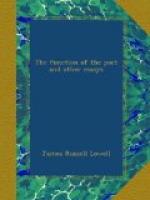The revival of the hexameter in modern poetry is due to Johann Heinrich Voss, a man of genius, an admirable metrist, and, Schlegel’s sneer to the contrary notwithstanding, hitherto the best translator of Homer. His “Odyssey” (1783), his “Iliad” (1791), and his “Luise” (1795), were confessedly Goethe’s teachers in this kind of verse. The “Hermann and Dorothea” of the latter (1798) was the first true poem written in modern hexameters. From Germany, Southey imported that and other classic metres into England, and we should be grateful to him, at least, for having given the model for Canning’s “Knife-grinder.” The exotic, however, again refused to take root, and for many years after we have no example of English hexameters. It was universally conceded that the temper of our language was unfriendly to them.
It remained for a man of true poetic genius to make them not only tolerated, but popular. Longfellow’s translation of “The Children of the Lord’s Supper” may have softened prejudice somewhat, but “Evangeline” (1847), though encumbered with too many descriptive irrelevancies, was so full of beauty, pathos, and melody, that it made converts by thousands to the hitherto ridiculed measure. More than this, it made Longfellow at once the most popular of contemporary English poets. Clough’s “Bothie”—poem whose singular merit has hitherto failed of the wide appreciation it deserves—followed not long after; and Kingsley’s “Andromeda” is yet damp from the press.
While we acknowledge that the victory thus won by “Evangeline” is a striking proof of the genius of the author, we confess that we have never been able to overcome the feeling that the new metre is a dangerous and deceitful one. It is too easy to write, and too uniform for true pleasure in reading. Its ease sometimes leads Mr. Longfellow into prose,—as in the verse
Combed and wattled gules and all the rest of the blazon,
and into a prosaic phraseology which has now and then infected his style in other metres, as where he says
Spectral gleam their snow-white dresses,
using a word as essentially unpoetic as “surtout or pea-jacket.” We think one great danger of the hexameter is, that it gradually accustoms the poet to be content with a certain regular recurrence of accented sounds, to the neglect of the poetic value of language and intensity of phrase.
But while we frankly avow our infidelity as regards the metre, we as frankly confess our admiration of the high qualities of “Miles Standish.” In construction we think it superior to “Evangeline”; the narrative is more straightforward, and the characters are defined with a firmer touch. It is a poem of wonderful picturesqueness, tenderness, and simplicity, and the situations are all conceived with the truest artistic feeling. Nothing can be better, to our thinking, than the picture of Standish and Alden in the opening scene, tinged as it is with a delicate




